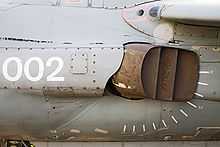Vectoring nozzle


Operational use of vectoring nozzles on aircraft began when the British Aerospace Harrier VTOL aircraft entered service with the Royal Air Force in 1968. In this aircraft, the conventional, rearwards jet exhaust was re-configured so that the bypass air and turbine exhaust from the Rolls-Royce Pegasus engine were expelled from two front(air) and two rear(exhaust) swivelling nozzles mounted on the sides of the fuselage. By altering the angle of these nozzles, the ratio of horizontal thrust to lift thrust could be varied, such that with the nozzles directed towards the ground, the aircraft could hover, stationary to the ground, and also move backwards.
On more recent fighter aircraft, pitch-axis thrust vectoring has been added to improve the turn rate of the aircraft by deflecting the exhaust gas stream using directional efflux nozzles. The Lockheed Martin F-22 Raptor and Sukhoi Su-30MKI are some examples.
External links
| Wikimedia Commons has media related to Vectoring nozzles (jet engines). |